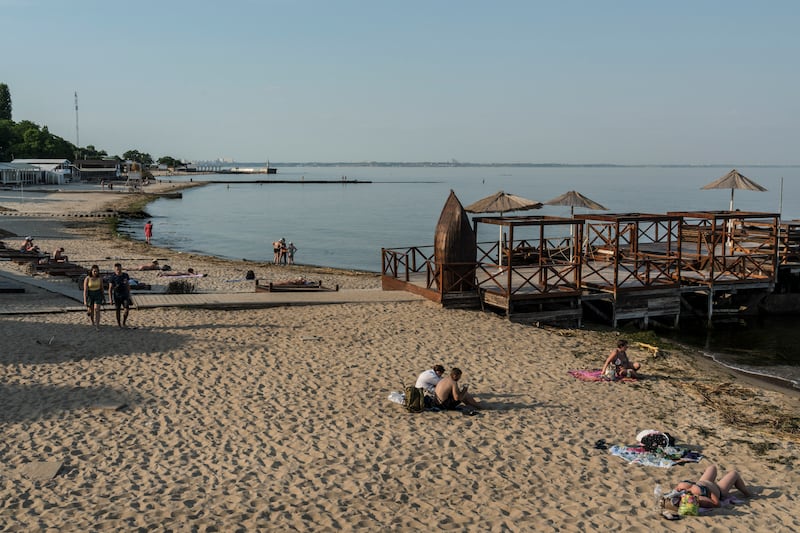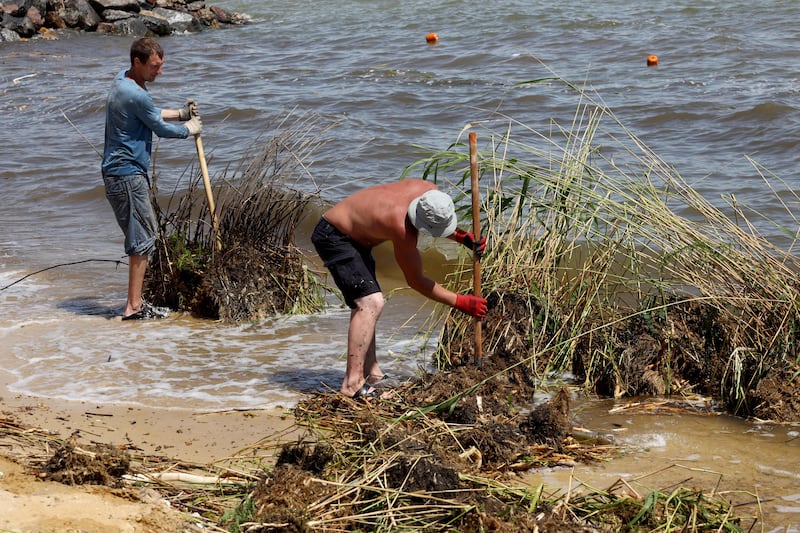Life in the famously freewheeling city of Odesa changed with Russia’s invasion of Ukraine, as warships fired cruise missiles at the city and blockaded its port, and residents used its beaches to fill sandbags rather than to sunbathe or swim in the Black Sea.
Odesa looked for ways to safely reopen some of its coastline for swimming this summer in a bid to boost ailing businesses and the spirits of war-weary locals, but those hopes have been destroyed along with the vast Kakhovka dam and swept away on floodwater that is now dumping mines, dead animals and the wreckage of cars and homes on the seashore.
As the Dnipro river disgorges debris from dozens of front-line towns and villages into the waves, Odesa is glimpsing the scale of the catastrophe unfolding further north, which Ukraine’s leaders and scientists call the latest crime in Russia’s “ecocide” against their nation.
The dam collapsed last Tuesday after what Kyiv says was an explosion caused by Russian troops who seized the facility and its hydroelectric power station when they invaded Ukraine in February 2022. Moscow blames Kyiv for the incident, but experts say it would have been almost impossible to breach the Soviet-built site from outside.
READ MORE

Dozens of people may have died and tens of thousands were displaced as 18 billion cubic metres of water held in a huge reservoir above the dam flooded the Kyiv-held western bank of the Dnipro and the occupied eastern side of the river in Kherson province.
The water level is now dropping in inundated areas, but experts say an entire ecosystem in southern Ukraine will be changed forever by the man-made disaster.
The flood carried an unknown volume of oil and other chemicals downstream, depositing them on land and washing them into the Black Sea, along with mines and other explosives that could take decades to find and make safe. Officials warn that floating sewage and the bodies of human and animal victims of the disaster add to the risk of disease this summer, and the supply of clean water to some 700,000 people has been affected.
The scale of destruction of wildlife, natural ecosystems, and entire national parks is incomparably greater than the consequences for the wilderness of all military operations since the start of the full-scale invasion
— Ukrainian Nature Conservation Group
The draining of the 2,000 sq km Kakhovka reservoir is bleeding dry an irrigation system that fed more than half a million hectares of farmland, which produced some four million of tonnes of crops, and could lead to “fields in the south of Ukraine possibly becoming deserts as early as next year”, Kyiv warned. With the exposure of the reservoir bed comes the danger that heavy metals from industrial waste will be released into the air.
Thousands of dead fish are already washing up beside the Dnipro and on the Odesa shoreline, and much of the spring spawn will not survive; a rich habitat for plants, insects, reptiles, birds – both resident and migratory – and mammals that developed over a century is now dying, posing a threat to several rare and endangered species.
“The scale of this catastrophe is difficult to compare with any previous events in Ukraine,” said the Ukrainian Nature Conservation Group, warning that the disaster would affect 47 national protected areas, including several national parks and the Black Sea biosphere reserve.
“Over the past 90 years, the floodplain of the Dnipro river in Ukraine has been regulated (with the construction of six dams) and populated by animals that lack effective mechanisms for escaping flooding ... In one day, some species’ populations faced a significant impact, maybe even bigger, than they have experienced in the past 100 years,” the group added.
[ Ukraine accuses Russia of destroying another damOpens in new window ]
[ Khakhovka dam blown up by Russia to prevent Ukrainian advance, says KyivOpens in new window ]
“In the short term, the consequences of the terrorist act ... are catastrophic for nature and people. The scale of destruction of wildlife, natural ecosystems, and entire national parks is incomparably greater than the consequences for the wilderness of all military operations since the start of the full-scale invasion in February 2022.”
Even before the destruction of the dam, Ukraine said a Russian onslaught that has killed tens of thousands of people and displaced millions had also caused tens of billions of euro in environmental damage, due to the destruction of industrial sites, infrastructure and contamination of land, sea and rivers with chemicals, mines and other explosives.
Ivan Rusev, director of science at the Tuzly Lagoons national nature park in Odesa region, said about 2,500 dead dolphins were washed up on the Ukrainian, Bulgarian and Romanian shores of the Black Sea in the first months of the full-scale war. Considering that most dead creatures sink, he estimated that 50,000 dolphins may have died during that time.
“When we found the dolphins, they were outwardly normal, intact, without damage from poaching nets, but they were dead. It means that they died due to the influence of military sonars,” he said. “There were many warships in the southwestern part of the Black Sea. And when they turned on the sonar, it disoriented the dolphins.”
Ukrainian president Volodymyr Zelenskiy has called the destruction of the dam “an environmental bomb of mass destruction” and the “largest man-made environmental disaster in Europe in decades”, and he is among several prominent figures – including environmental activist Greta Thunberg – to accuse Russia of committing “ecocide”.
Kyiv prosecutors are investigating the incident as a potential war crime and ecocide, which Ukrainian legislation defines as “mass destruction of flora and fauna, poisoning of air or water resources, and also any other actions that may cause an environmental disaster”.

Zelenskiy said on Monday that representatives of the International Criminal Court had started investigative work in Kherson region and although the tribunal based in The Hague does not include the crime of ecocide in its statute, other articles relating to wanton destruction of civilian infrastructure and the environment may apply in this case.
The disaster also heightened fears for the Russian-occupied Zaporizhzhia atomic power station, the biggest in Europe, which is about 140km north of the destroyed dam and draws water from the now dwindling Kakhovka reservoir to cool its six reactors and stores of spent nuclear fuel.
The International Atomic Energy Agency says there is enough water on-site to provide cooling for several months, and its director Rafael Grossi plans to visit the plant this month, having repeatedly failed to secure agreement for the creation of a “security zone” around a facility that Ukraine and Russia accuse each other’s forces of shelling.
Downstream in Odesa, meanwhile, people are resigned to losing another summer of seaside pleasures to the war, and beaches that were packed in peacetime are dotted only with cautious walkers and volunteers helping the clean-up effort.
Ihor Belyakov, director of Odesa zoo, said locals were calling his office for help and advice on what do with flood-borne animals found alive on the seashore, including frogs, newts, muskrats and snakes. Local media are also celebrating an ageing dog for apparently managing to “surf” more than 100km from the flood zone to the Odesa coast on driftwood.
The mayor’s office reminded locals that it was still forbidden to visit beaches and swim in the sea, and said security would be increased on the coastline to enforce the ban. Nonetheless, Odesa deputy Oleksiy Honcharenko was one of many to post videos online showing how roofs, walls, furniture and appliances from smashed Kherson homes were now washing ashore.
Odesa news website Dumskaya also urged well-meaning volunteers to think about what could be lurking in the floodwater and leave the clean-up operation to experts.
“Mines are extremely dangerous objects that can only be handled by highly qualified specialists,” it warned in an editorial. “Do not put yourself and your loved ones in danger, do not go to the beaches and do not even think about swimming! It was risky before (anti-ship mines are still drifting in the sea), but now it has become real Russian roulette.”






















